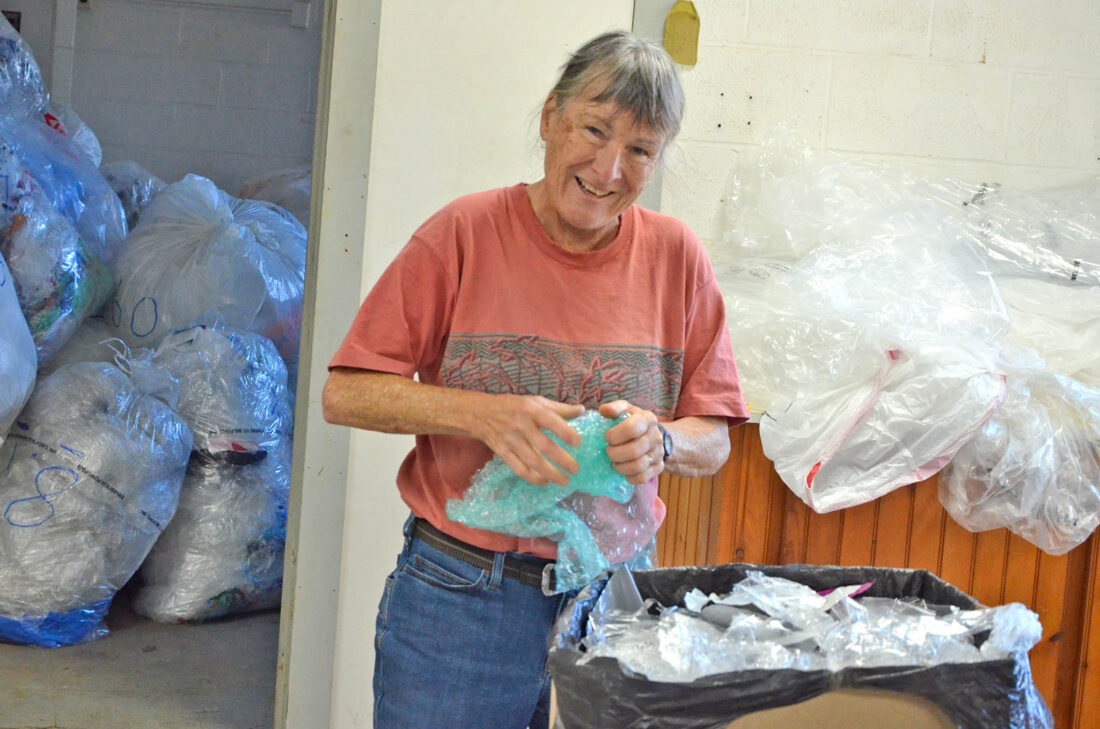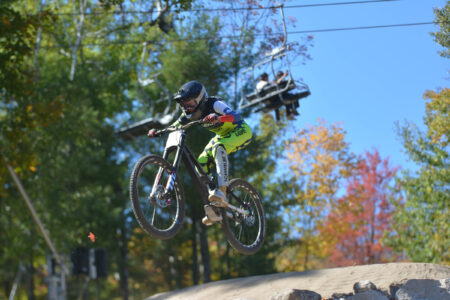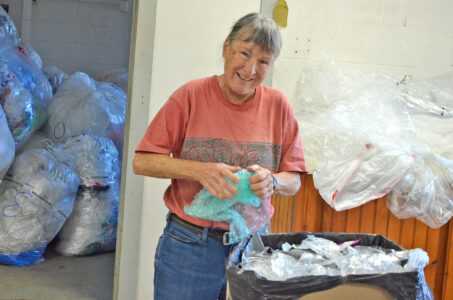Volunteers sought to sort plastic
Community Bench Program has recycled 12,000 pounds of plastic

Sue Capone sorts plastic Friday while volunteering with the Community Bench Project. (Enterprise photo — Aaron Marbone)
SARANAC LAKE — The sound of plastic rustling, friendly chit-chat and scissors snipping away filled the garage at 33 Petrova Ave. on Friday morning as volunteers with the Community Bench Project set to work sorting hundreds of pounds of stretchable polyethylene plastic.
For a year and a half, the lively crew has been collecting plastic which is otherwise unrecyclable and trading it in to a composite decking company in exchange for a dozen benches they’ve helped distribute around town.
The group formed in the spring of 2024 after Trudeau Institute researcher In-Jeong Kim brought the idea to the Saranac Lake Women’s Civic Chamber. She had learned that the composite decking company Trex has a NexTrex bench program where groups give Trex 1,000 pounds of a specific type of plastic to make “lumber” from, and Trex gives them a free bench made from its lumber in return.
Now, they have earned 12 benches representing 12,000 pounds of plastic no longer polluting the world and being used for construction instead.
“The community has embraced the recycling effort,” volunteer co-organizer Liz Murray said.
What they need more of now is volunteers. Separating usable plastic from the many look-alike unusable plastics they get in the drop-off boxes takes a lot of effort. Also, many usable plastics need to be trimmed of stickers, labels and tape.
“We end up with a lot of bad plastic,” Murray said.
Frozen vegetable bags are the most common bad type of plastic they get. It’s too crinkly to be used in the composite decking.
Volunteers also emphasized that they want clean and dry plastic.
Mulch bags are the right material, but they are always dirty, which makes them unusable. Wood pellet bags are good. If people turn their bags inside out at home to shake out the crumbs, it makes the job a lot easier, the group said.
Also, cutting off labels and tape helps them, as does removing the paper from bubble wrap mailers.
“It’s amazing how many items come in their own individual plastic bags,” volunteer co-organizer Karen Russell said.
Shirts at clothing stores are shipped individually, packaged in plastic bags. Each bag has a label the volunteers have to cut off.
“Our scissors are actually getting dull,” volunteer co-organizer Elle Finocan said.
“And we fight over the good ones,” Murray said.
If someone wants to help but doesn’t have time, they said they can always use scissors, big clear plastic bags and hand wipes.
“It’s a dirty job,” Murray said.
The NexTrex program allows for one bench a year. So after the volunteers quickly collected their first 1,000 pounds, they asked themselves, “Now what?”
They go around to local organizations and make an offer — if the organization provides them with some volunteers to help process the plastic for a month, they get a bench in return.
“Any group that wants to donate volunteer hours for a month, you can earn a bench,” Murray said.
They work with nonprofits, civic organizations and local governments. They are open to working with businesses, but said they’d have to contribute quite a bit of volunteer effort.
Women’s Civic Chamber has two benches, Voters for Change has two. Benches have also been acquired by Northern Lights School, the Rotary Club, Elks Club, Saranac Lake Free Library, the Ice Palace Workers 101, Pine Ridge Cemetery and the Adirondack Carousel.
The “small army” of volunteers meets every Friday and Saturday at 9:30 a.m. in the back of the former St. Pius X High School on Petrova Avenue. Usually, they draw between five and 15 people.
They’re a chatty group. Each of the organizers said they’ve made new friends through volunteering.
“There’s really good camaraderie,” Finocan said. She compared it to the atmosphere at the Winter Carnival Ice Palace build.
Russell compared it to a quilting circle. But instead of making blankets, they’re making benches — and keeping the planet cleaner at the same time.
She said it feels good to be constructive and to know they’re making a difference.
“My big nightmare is that big ball of plastic in the ocean,” Murray said.
The Great Pacific Garbage Patch is the largest island of trash. Located between Hawaii and California, it holds a potential of 2 million tons of plastic in an area twice the size of Texas.
Stretchable polyethylene plastic film is hard to dispose of responsibly. Trash and curbside recycling companies don’t want it because it gums up their machines. If it’s not just thrown away, it usually ends in zero-sort recycling bins, which are not reliably recycled well.
These are plastics that would usually end up in the trash but can be recycled into usable construction products. Trex mixes this plastic with wood chips in a 95% to 5% ratio to create its composite lumber.
Plastic bags are one of the biggest killers of marine animals. The World Wildlife Fund estimates that plastic pollution kills 100,000 marine mammals every year, everything from turtles to whales. The bags look like squid or jellyfish to these predators.
Specifically, it is stretchable polyethylene plastic — mostly #4 Low Density Polyethylene and some thin #2 High Density Polyethylene in recycling terms.
Stretchable polyethylene plastics include grocery and retail bags, Ziploc bags, bread bags, newspaper sleeves, bubble wrap, water bottle case overwrap, produce bags, toilet paper and paper towel wrap, ice bags, wood pellet bags, salt bags, cereal box liners, pallet wrap, air pillows, plastic shipping envelopes, electronics wrap and dry cleaning bags. Any stretchy plastic film labeled with a #2 or #4 recycling symbol is the right kind.
All of the plastic must be clean and dry.
There are a couple of methods to determine if a plastic is the correct kind. It should be stretchy. If it tears, is crinkly or crunchy, or shiny, then it’s the wrong kind.
Russell said, unfortunately, they cannot accept boat wrap. It’s the right material, but after it sits out all winter, it gets covered in salt and sand and is not acceptable for composite decking.
Another way to test is to hold a flame to it. If it drips when burned and smells like wax when the flame is snuffed out, then it is the right kind.
Examples of what not to donate include frozen food bags, candy wrappers, chip bags, net or mesh produce bags, pet food bags, six-pack rings, personal protective equipment, pool covers, meat wrapping, shower curtains and tablecloths.
The Community Bench Project Facebook page lists examples of good and bad plastic at tinyurl.com/yw5h72at.
Caperton Tissot told organizers that after she helped process the plastic for the first time, she had a better idea of how to pre-prepare the plastic at home. She also wrote a poem about the experience, which is printed in full below.
Liquor stores, furniture stores and other retailers drop off their pallet wrap.
“I think the businesses appreciate it,” Russell said.
Otherwise, the businesses would be paying to get rid of the plastic as trash. Murray said they’re always looking for more businesses that want to participate.
The primary drop-off stop for plastic is at a shed near the rear corner of the building at 33 Petrova Ave. There are drop-off boxes at Nori’s cafe, Kinney Drugs, the Harrietstown town hall and Woods and Waters.
The volunteers work through the winter in the unheated building, wearing hats and gloves as they keep themselves warm by keeping busy.
Murray said the village has been “awesome,” allowing the group to use the former school at 33 Petrova Ave. The village has plans to turn this building into an emergency services complex in the future, but it sits empty for now.
She said their longevity relies on using 33 Petrova right now. The plastic takes up a lot of room. It actually fills an entire garage bay.
Finocan still remembers how excited the group got a year and a half ago when they collected their first little pile.
–
A poem about the Community Bench Program
–
Come help us,
come answer the need,
join folks sorting
through plastic debris
To be bundled in bags
and carefully weighed,
transported, recycled,
to benches be made
Less to the landfill,
less to the sea
less ground pollution
though we all agree
It’s better if never
plastics be made
but until they invent
a degradable grade
Volunteers work
day after day
to do what they can
in their humble way
To make a difference
on this troubled earth,
turn bad to good
through plastic rebirth
Eleven benches
bring rest and delight
thanks to volunteers
working out of sight
Help is needed
More hands to assist
More folks working
For that is the gist
Come down and join us,
we need more on board,
it’s a worthy job,
that’s the reward
— Caperton Tissot



